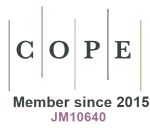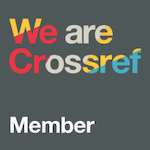Publication ethics
Authorship | Competing interests | Research misconduct | Image manipulation | Data availability | Human subjects | Embryos, gametes, stem cells | Animals | Plants | Research reporting guidelines | Trial registration
General information
The Publisher and the Journal are committed to a transparent, fair and objective peer-review process with the aim of publishing unbiased and ethically selected articles. We expect our authors, reviewers and editors to follow ethical guidelines to maintain an accurate and transparent academic record.
This document outlines the most relevant ethical standards, but are not exhaustive. Journal of Circulating Biomarkers follows COPE’s guidelines for handling potentially unethical behaviour by authors, reviewers or editors and we encourage authors, reviewers and editors to refer to the COPE website and guidelines for further guidance.
In case of concerns raised by readers we will investigate using procedures recommended by COPE and wherever possible they will be resolved by the editorial board. We expect authors to respond responsibly to any allegation made against them.
Research integrity
Research integrity is a broad term which identifies different types of unethical behaviour during the research and publication process. In Journal of Circulating Biomarkers authors are required to warrant, during the submission process, that their study and the submitted article meets all integrity criteria which are outlined below. A breach in research integrity may result in the article being rejected.
Authorship
Each person listed as an author should have participated sufficiently in the work to take public responsibility for the content and agree to be accountable for all aspects related to its accuracy or integrity. The participation must include:
- Substantial contributions to the conception or design of the work; or the acquisition, analysis, or interpretation of data for the work; AND
- Drafting the work or revising it critically for important intellectual content; AND
- Final approval of the version to be published; AND
- Agreement to be accountable for all aspects of the work in ensuring that questions related to the accuracy or integrity of any part of the work are appropriately investigated and resolved.
Authors who do not meet the above criteria should be acknowledged in the Acknowledgments section.
We encourage all authors to supply their ORCID and to include in a statement individual contributions following the CredIt taxonomy.
The participation of scientific and medical writers should be acknowledged by disclosing their funding. If a study has been conducted by a large multicenter group, you should identify the individuals responsible for its submission, who should fully meet criteria for authorship. Authors from pharmaceutical companies, or other commercial organizations sponsoring research papers should declare these as competing interests during the submission.
Natural language processing tools driven by artificial intelligence (AI) do not meet authorship criteria. The use of artificial intelligence or LLM tools to create or assist with writing or editing the manuscript, should be listed in acknowledgement section.
Corresponding author
The corresponding author is responsible for submission and all communication with the Journal regarding that submission. It is the corresponding author’s responsibility to ensure that all authors meet the required authorship criteria indicated above and for ensuring that the acknowledgements and disclosures included in the manuscript are accurate and up-to-date.
If the submission is accepted, the corresponding author will receive all relevant communications from the journal, will be expected to review and approve the proofs, process publication fees when required and act as a point of reference for post-publication enquiries on the published paper.
Order of authors
Once a manuscript has been submitted, the order of authorship (including addition or removal of authors) cannot be changed without a written request to the Editorial Office made by the Corresponding Author. Should agreement between authors not be reached, the manuscript will be withdrawn.
Authorship changes cannot be submitted with proof changes. The publisher is not allowed to make such changes and it will delay the publication of your manuscript.
Name changes
While it is not possible to change authorship during peer review, we are aware that in rare cases there may be the need for an author to change his/her name before or after publication. We will handle requests confidentially using a case-by-case approach.
Group authors
In case a group of authors is included in the author list, all members must meet full authorship criteria. Group authors will be listed at the end of the article.
Competing interests
Authors, reviewers and editors are required to disclose any conflict of interest (that is financial or personal relationships or affiliations that could influence their work) and sources of financial and material support received.
Research misconduct
Research misconduct identifies fabrication, falsification, or plagiarism in proposing, performing, or reviewing research, or in reporting research results
Authors must avoid duplicate publication, which is reproducing verbatim content from their other publications. Recycling text from their own previous publications may be considered self-plagiarism, and may be unacceptable. Full attribution and compliance with copyright must be ensured when using the authors’ own previous publications.
Theft or misappropriation of intellectual property and/or the substantial unattributed textual copying of another's work constitutes plagiarism. This journal systematically employs iThenticate, a plagiarism detection and prevention software designed to ensure the originality of written work before publication. Manuscripts proved to include plagiarized content will be rejected.
Inappropriate image manipulation is a recognized form of data fabrication or falsification. Figure and illustrations submitted with an article must be original. Any figure that has been published elsewhere must have an acknowledgment to the original source; a copy of the permission to publish the figure, signed by the copyright holder, must accompany the submission. Image manipulation that may affect data interpretation is a frequent cause of rejection or retraction. The use of generative or non-generative machine learning tools to create, combine, enhance and edit existing images must be disclosed in the figure legend.
Data availability.
Authors must ensure that original research data remain available after publication through appropriate archiving. We recommend that a statement about where data supporting the results reported in a published article can be found, including, where applicable, unique identifiers linking to publicly archived datasets analyzed or generated during the study.
Research ethics
Research ethics is a broad term which identifies the ethical approach to developing a research study.
Research on human subjects
When human subjects are involved in a study it is suggested that journals require authors to provide a statement identifying the ethics committee that approved the study (IRB approval), and that the study conforms to recognized standards (e.g. Declaration of Helsinki; European Medicines Agency Guidelines for Good Clinical Practice). These standards encourage authors to conduct studies in a way that ensures adequate steps have been taken to minimize risks to participants and to protect their confidentiality.
Patient confidentiality
Whenever a study or case report includes data or images which could identify a patient, explicit written consent for publication (which is different from consent to take part in research) must be obtained and included in the submitted article. In case of minors, the consent must be signed by a parent or guardian.
When organ transplantation is described in the article author should state that they adhered to the Declaration of Istanbul, which specifically addresses delicate subjects relative to organ supply.
Sex and gender
Authors are encouraged to adopt the ‘Sex and Gender Equity in Research – SAGER – guidelines’ using the terms sex (biological attribute) and gender (shaped by social and cultural circumstances) where relevant, to avoid confusing both terms .
Research on human embryos, gametes and stem cells
When human embryos, gametes, stem cells and related material are involved in a study, we recommend that authors provide a statement that the study conforms to recognized standards .
Research involving animals
When animals are involved in research, authors should ensure that these were conducted according to animal research reporting standards.
Research involving plants
Whenever a study reports experimental research on plants (either cultivated or wild), authors must provide a statement identifying confirming compliance with relevant institutional, national, and international guidelines and legislation.
Research reporting guidelines are intended to guide authors to provide enough information for editors, peer-reviewers and readers to understand how the research was performed and to judge whether the findings are likely to be reliable. The EQUATOR Network provides detailed study-specific guidelines.
Clinical trial registration
All clinical trials must be registered at an appropriate online public registry that should be electronically searchable and includes a minimum of data elements (www.icmje.org). Trial registry name, registration identification number, and the URL for the registry should be included in the manuscript.






